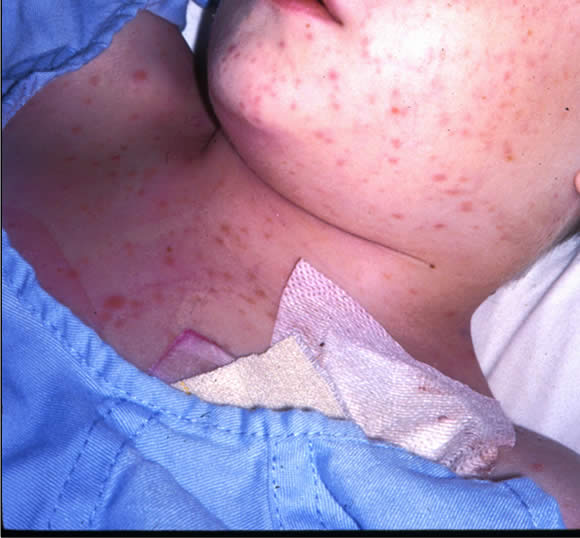Disseminated Intravascular Coagulation (DIC)
Intravascular consumption of platelets and plasma clotting factors.
- Uncontrolled activation of coagulation and fibrinolysis
- Consumption of clotting factors and platelets
There is widespread coagulation within blood vessels leading to the deposition of fibrin thrombi and hemorrhage when all the clotting factors and platelets have been used up.
The accumulation of fibrin in the tiny blood vessels leads to mechanical damage to red blood cells and a "microangiopathic hemolytic anemia".
Presents with :
- Bruising and bleeding
- can lead to shock, intracranial bleeding, death
Below is a typical purpuric rash associated with DIC:

DIC occurs in patients with severe illnesses
Classically occurs in subtypes of AML especially AML M3 (Acute promyelocytic leukemia)
Diseases associated with DIC:
| Tissue Injury | Trauma/Crush injuries. Head Injury. Major surgery |
| Burns | |
| Malignancy | |
| Venoms | |
Endothelial cell Injury &/ Abnormal Vascular surfaces |
Infection (bacterial, viral or protozoal)
|
| Giant Hemangioma | |
| Malignancy | |
| Cardiopulmonary bypass | |
Platelet or leukocyte or red cell injury |
Incompatible blood transfusions |
| Infection | |
| Allograft rejection | |
| Drug hypersensitivity | |
| Malignancy | |
| Hemolytic syndromes |
Laboratory Results
- ↓ platelets
- ↑ PT, PTT
- ↓ fibrinogen
- ↑ FDP’s
- ↓ clotting factors
Management
- Treat the underlying cause
- Fresh Frozen Plasma / Cryoprecipitate / platelets
- Packed Red Blood Cells
- Heparin → - controversial, - switches off thrombin production - ??only recommended when aggressive replacement therapy fails to correct a dangerous coagulopathy

